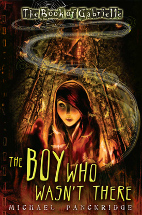The boy who wasn't there by Michael Panckridge

The book of Gabrielle. Book 1. Black dog books, 2011.
The boy who wasn't there begins with an air of mystery and
intrigue.
Who is this girl in the hospital bed? What has happened in her life
prior to this time? Who is the boy with his own story to tell (and his
own pages to tell it)? What is the Voice in her head really saying, as
it tells her 'You are not like anyone else'?
This is the first offering in a new series from Michael Panckridge,
whom I know best for his sporting stories, and in particular The
Legends series. It is the first book in The Book of Gabrielle
series.
The second book in the series The boy without a soul is already
on its
way.
The girl in the hospital bed is Gabby (Gabrielle), seemingly an orphan.
She is fostered by Jane and Phil Calvert for 4 weeks of the January
school holidays. Gabby is a strong and adventurous character, who
doesn't hesitate to explore her new home including the treasures and
mysteries of the attic.
There are strange happenings in this house. Michael Panckridge uses
strong imagery to create the horrors of these happenings eg the
incidents in Gabby's bedroom firstly with the swarm of moths and later
with the suffocating weight on her chest; and the terror of the spiders
and cockroaches in the incident in the attic.
On occasions the narrative seems a little disconnected; it doesn't
quite gel. The reader has to work hard at connecting the incidents as
the narrative progresses. On the first reading it is difficult to know
at times which character is speaking. Some of this confusion could have
been resolved with more precise editing. It would have been a more
satisfying read, too, if the characters had been more fully explored,
particularly in regard to sudden changes in their attitude, which occur
as the story reaches its resolution.
Nevertheless, I think that children in the Middle School years will
enjoy the sense of mystery, the ghoulish incidents with the creepy
crawlies, the ghostly nature of the boy, Peter and Gabby's success in
healing old wounds.
Margaret Strickland